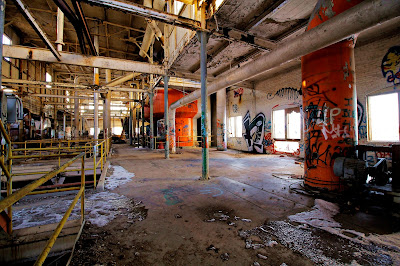That sums up my start to the 2016 urbex year.
A couple years back, I hit up this location with a couple friends, but we had to beat a hasty escape as our exploring time was cut short when we ran into the owners. How we were not seen or caught is beyond me, but we got out. Ever since that day, I had always dreamed of returning and fully exploring this magnificent piece of Colorado history and of Colorado's urbex scene.
This is the Longmont Sugar Mill.
You cannot drive through eastern Longmont without noticing this beast. The sprawling complex is easily seen from I-25, miles away.
Let's go back in time a bit, shall we?
Ground was broken for the mill in January of 1903. A massive $1,000,000 investment kicked off construction. This was an astronomical sum of money for the time, seeing as to how sugar beet mills only operated four months out of the year. Longmont had very rich soil, making it an ideal location for sugar beets to be grown. Before the construction was even started on the mill, over 4,000 acres of sugar beets had been planted around the proposed location. There was some controversy surrounding the construction of the mill initially, as there was concern that there would be an over saturation of sugar factories around Longmont.
Once a compromise was reached, construction started on the Longmont Sugar Mill. Here is an interesting piece of information concerning the construction of the mill from longmontian.blogspot.com, "The Longmont factory was the first in northeast Colorado to be funded exclusively with out-of-state capital, leading local factory organizers to remind Longmont citizens that the factory would not cost them a single penny." The mill was built to handle 600 tons of processed beats daily, but there was a catch. The mill was designed to be over built so that it could handle twice the initial capacity of sugar beats should it be necessary for the following seasons. The mill was constructed by the Kilby Manufacturing Company of Cleveland, Ohio. Only a couple years after construction, the mill was acquired by the Great Western Sugar Company, a company that would eventually own 15 sugar beet mills along the Front Range.
By 1920, sugar was the mainstay for Colorado, with harvest value almost 20 times what it was in 1900. The Longmont Sugar Mill, in its heyday, was processing an unthinkable 2,500 tons of sugar beets DAILY. By using the simple equation of 1 ton of sugar beets = 300 pounds refined sugar, the mill was outputting almost 750,000 pounds of refine sugar a day. Wow!
To keep the refined sugar from sugar beats profitable, the Dingley Act of 1897 put a tax of $1.95 per 100 pounds of imported sugar. This is effectively what kick started the building of sugar factories around Colorado.
The Longmont Sugar Mill employed 600 workers who worked around the clock to keep the mill flowing. The mill also employed a 3,000 horsepower steam system. The steam system was harnessed through the entire mill via a complex system of pipes, levers, pulleys and more, and was the backbone that kept the sugar flowing out. The mill also had it's own chemistry and assay departments, which would measure the sugar content of incoming beets.
Eventually, the sugar beet mills fell victim to imported cane sugar, and all but one of these great mills were shut down. The Longmont Sugar Mill in particular closed it's doors for the last time in 1977.
All that remains now is but a ghost of it's once magnificent past. Empty buildings sit abandoned, the machinery housed withing, idle and quiet. A eerie silence perforates the entire complex, as all that can be heard now are the echoing drippings of water, flapping of pigeons and the occasional creak as a breeze weaves throughout the maze of pipes and walkways.
My return trip to kick off this year was incredible. I was finally able to explore the vast maze of pipes and walkways in the northern building. This is the closest you can get in Colorado to the famed factories of the eastern U.S. Walking amongst the silent machinery, I couldn't help but imagine the controlled chaos and noise that the mill produced on a daily basis. It is sad that this is one of only four sugar mills that remain standing in Colorado. This place is one of the most incredible and awe inspiring locations I have ever visited.
Historic photo of the Longmont Mill:
Map of the mill:
Photos from my exploration:


































No comments:
Post a Comment